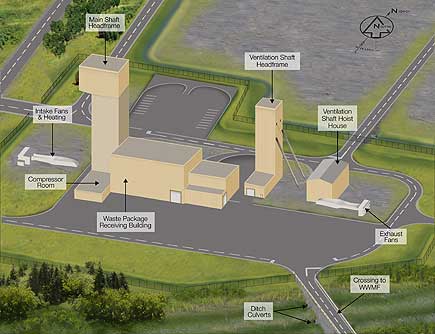KINCARDINE—The Expositor learned recently that the Kincardine bid for a deep geological repository (DGR), 1.2 kilometres from the shores of Lake Huron, is nearing the end of its public comment phase and coming ever closer to reality.
Beverly Fernandez, speaking on behalf of the group Stop the Great Lakes Nuclear Dump, explained that this has been a 12-year process with the Ontario Power Generation (OPG) and the community of Kincardine.
The OPG’s plan is to create a DGR 680 metres below the surface (taller than the CN Tower) and 1.2 kilometres from Lake Huron to house low and intermediate waste from the OPG’s nuclear sites, including the nearby Bruce Power plant. (Low and intermediate waste includes, mops, coveralls, filters and resins.) Bruce Power has been storing its low and intermediate waste on site for the past 40 years in mainly above-ground storage areas, OPG’s Neal Kelly, media director, explained to The Expositor on Monday.
“This dump site puts at risk the fresh water of the Great Lakes, 21 percent of the world’s surface fresh water relied upon by 40 million people in two countries,” Ms. Fernandez said. “We are bringing this issue to the public’s attention because we believe that Canadians and Americans deserve the opportunity to learn more and voice their opinions on an issue that will affect generations to come.”
The public comment period on the project is now, but is expected to end soon, with the Canadian Environmental Assessment Agency (CEAA) to give a 30-day notice period before comments are closed, Mr. Kelly explained. Stop the Great Lakes Nuclear Dump expects the process to be approved in as little as nine months. According to a press release from this group, the OPG has paid out $10.5 million to the municipality of Kincardine and four adjacent municipalities “in an effort to secure local support before approval to construct the dump has even been received.” The release continues to state that these five municipalities are expected to receive in excess of $35.7 million over a 30-year period should the federal government approve the plan.
“Why bury the most toxic waste created by humans right beside our water?” Ms. Fernandez questioned. “It is of national and international concern, and the decision should not be left in the hands of one community.”
She spoke of Asse II, a DGR in Germany which also sought to house low to intermediate nuclear waste and which was also ensured to be safe, only to have the 250 million-year-old rock leak the waste. “The scientists and geologists were dead wrong and they cannot reverse the process,” she said. “This should cause us all a great deal of concern.”
“Canada has a very vast land mass—why would the OPG bury material here, in a populated area with fresh drinking water for 40 million people?” Ms. Fernandez asked. “I don’t feel this is an appropriate decision for one community to make,” she reiterated, “when it affects 40 million people in two countries. This is an issue all Canadians should be concerned about, not just over 4,000 people,” (the population of the Kincardine area).
Mr. Kelly encouraged interested parties to study the documents, available at www.opg.com/dgr, to come to their own conclusions on the project which, he said, “is a good, responsible project.”
The waste from Bruce, Pickering and Darlington OPG nuclear sites would all be brought to the Kincardine DGR, Mr. Kelly explained.
“In terms of the lake, the waste is located 1.2 kilometres from Lake Huron in 450-million-year-old stable rock in a seismically quiet area,” Mr. Kelly said. “Experts from around the world agree it’s a responsible choice for location,” he added, noting that studies show no adverse affects to the environment from such a DGR.
According to an article in the Saugeen Times, construction of the facility is expected to take five years and, once the operating licence is approved, up and running by 2018.
The Canadian Environmental Assessment Agency and the Canadian Nuclear Safety Commission are running the joint panel review (reference number 17520, www. www.ceaa-acee.gc.ca) and the OPG anticipates a public hearing to be held in Kincardine late this year.
Mr. Kelly called the Kincardine community “willing and supportive,” adding that the project has been studied for several years and is based on international best practices.
Mr. Kelly repeatedly noted the distance of the DGR from Lake Huron, 1.2 kilometres.
For more information on the DGR, visit the OPG, CEAA or Nuclear Waste Management Organization sites.





